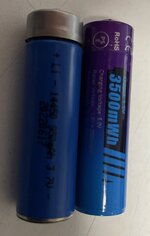mWh and mAh are related. The mWh is the result of multiplying mAh by the voltage of the system. You may find the rechargeable 1.5V Li-ion battery is rated with mWh instead of mAh. Because the voltage of this battery remains constant 1.5V until it's almost completely discharged. It means that the energy stored in a rechargeable 1.5V Li-ion battery is proportional to the product of the voltage and the capacity, which is expressed in mWh. As for other types of rechargeable batteries, such as 1.2V NiMH batteries, have a variable voltage during discharge, which makes it more suitable to express their capacity in terms of mAh.
Some people compare the capacity and discharge time of the rechargeable 1.5V Li-ion AA/AAA batteries & 1.2V NiMH AA/AAA batteries. They may think the 1.5V Li-ion batteries are not so preferable to NiMH batteries. But the 1.5V Li-ion batteries keep constant 1.5V output. The discharge voltage of the NiMH batteries continue to drop during usage. So we can't do a simple formula conversion and make comparison. The overall performance is more important.
For devices that require a steady and stable high-voltage output over a long period of time, they are definitely stronger with 1.5V Li-ion batteries. Such as, RC cars, VR controllers, digital cameras, blood pressure meters, some smart household appliance etc. They may consider 1.2V NiMH a low or dead battery, and constantly need to replace new battery. The 1.5V Li-ion batteries can maintain more stable performance.
Some people compare the capacity and discharge time of the rechargeable 1.5V Li-ion AA/AAA batteries & 1.2V NiMH AA/AAA batteries. They may think the 1.5V Li-ion batteries are not so preferable to NiMH batteries. But the 1.5V Li-ion batteries keep constant 1.5V output. The discharge voltage of the NiMH batteries continue to drop during usage. So we can't do a simple formula conversion and make comparison. The overall performance is more important.
For devices that require a steady and stable high-voltage output over a long period of time, they are definitely stronger with 1.5V Li-ion batteries. Such as, RC cars, VR controllers, digital cameras, blood pressure meters, some smart household appliance etc. They may consider 1.2V NiMH a low or dead battery, and constantly need to replace new battery. The 1.5V Li-ion batteries can maintain more stable performance.


